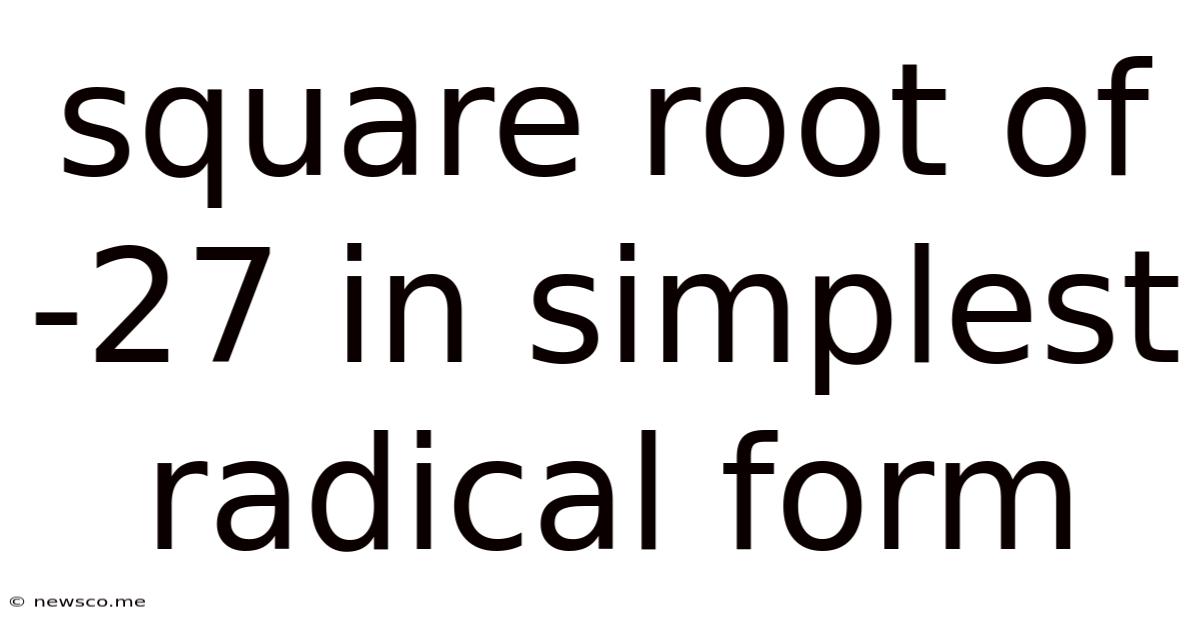Square Root Of -27 In Simplest Radical Form
News Co
Mar 15, 2025 · 4 min read

Table of Contents
Square Root of -27 in Simplest Radical Form: A Comprehensive Guide
The square root of -27, denoted as √-27, presents a unique challenge in mathematics because it involves the square root of a negative number. Understanding how to simplify this expression requires a grasp of imaginary numbers and the rules of radical simplification. This comprehensive guide will walk you through the process step-by-step, explaining the concepts and providing examples to solidify your understanding.
Understanding Imaginary Numbers
Before we tackle the square root of -27, let's clarify the concept of imaginary numbers. The square root of a negative number is not a real number. Real numbers are the numbers we typically use in everyday life, including positive and negative numbers, fractions, and decimals. Imaginary numbers were invented to address the problem of taking the square root of a negative number.
The fundamental imaginary unit is denoted by the letter i, defined as:
i = √-1
This means that i squared is -1:
i² = -1
Imaginary numbers are numbers of the form bi, where b is a real number. For example, 2i, -5i, and πi are all imaginary numbers.
Simplifying √-27
Now, let's approach the simplification of √-27. The key is to separate the negative sign from the number:
√-27 = √(-1 * 27)
Using the property of radicals that √(ab) = √a * √b, we can rewrite this as:
√(-1 * 27) = √-1 * √27
Remember that √-1 = i. Therefore:
√-27 = i√27
This expression is still not in its simplest radical form because 27 can be simplified.
Simplifying the Radical √27
To simplify √27, we need to find its prime factorization. The prime factorization of 27 is 3 x 3 x 3, or 3³. Therefore:
√27 = √(3³)= √(3² * 3) = √3² * √3 = 3√3
Substituting this back into our expression for √-27:
√-27 = i√27 = i * 3√3 = 3√3i
Therefore, the simplest radical form of the square root of -27 is 3√3i or 3i√3. Both notations are commonly used and equally correct. The important aspect is to understand that the i represents the imaginary unit resulting from the negative under the square root.
Complex Numbers: A Deeper Dive
The result, 3√3i, is a complex number. Complex numbers are numbers that have both a real part and an imaginary part. They are expressed in the form a + bi, where a is the real part, and b is the imaginary part. In our case, a = 0 and b = 3√3. So, we can write √-27 as 0 + 3√3i.
Understanding complex numbers is crucial for more advanced mathematical concepts in areas like calculus, linear algebra, and electrical engineering. They provide a powerful tool for solving problems that cannot be solved using real numbers alone.
Practical Applications of Imaginary and Complex Numbers
While imaginary numbers might seem abstract, they have numerous practical applications in various fields:
1. Electrical Engineering:
Imaginary numbers are fundamental in analyzing alternating current (AC) circuits. They are used to represent impedance, which is a measure of opposition to the flow of current. Calculations involving impedance frequently use complex numbers to account for both resistance and reactance (the opposition to changes in current).
2. Quantum Mechanics:
In quantum mechanics, imaginary numbers are used to describe the wave function of particles. This wave function provides a mathematical description of the probability of finding a particle in a specific state.
3. Signal Processing:
Complex numbers are essential in signal processing for representing signals in the frequency domain. This allows for efficient manipulation and analysis of signals, leading to applications in audio processing, image processing, and communication systems.
4. Fluid Dynamics:
Complex numbers are used in fluid dynamics to model the flow of fluids, especially in scenarios involving complex geometries or turbulent flow.
5. Aerodynamics:
In aerodynamics, complex numbers play a role in the analysis of airfoil design and performance prediction.
Further Exploration: Higher Order Roots of Negative Numbers
The concept extends beyond square roots. Consider the cube root of -27:
∛-27 = -3
This is because (-3)³ = -27. This differs from the square root because an odd-numbered root of a negative number yields a negative real number result. Even-numbered roots of negative numbers, however, result in imaginary numbers.
Solving Equations Involving √-27
Let's consider an example of an equation that involves √-27:
x² + 27 = 0
Subtracting 27 from both sides:
x² = -27
Taking the square root of both sides:
x = ±√-27
x = ±3√3i
Therefore, the solutions to the equation x² + 27 = 0 are 3√3i and -3√3i. These are complex conjugate pairs, a common occurrence in the solution of quadratic equations with negative discriminants.
Summary: Simplifying √-27 and its Implications
Simplifying the square root of -27 to its simplest radical form, 3√3i, requires understanding imaginary numbers and their significance in mathematics. While seemingly abstract, the concept of imaginary numbers is fundamental to various fields of science and engineering. This article has provided a comprehensive guide to understanding this concept, including its practical implications and applications in various disciplines. Mastering this foundational concept opens the door to a deeper understanding of complex numbers and their role in higher-level mathematics and scientific applications. Remember that consistent practice and working through numerous examples are essential for solidifying your understanding of these concepts.
Latest Posts
Related Post
Thank you for visiting our website which covers about Square Root Of -27 In Simplest Radical Form . We hope the information provided has been useful to you. Feel free to contact us if you have any questions or need further assistance. See you next time and don't miss to bookmark.